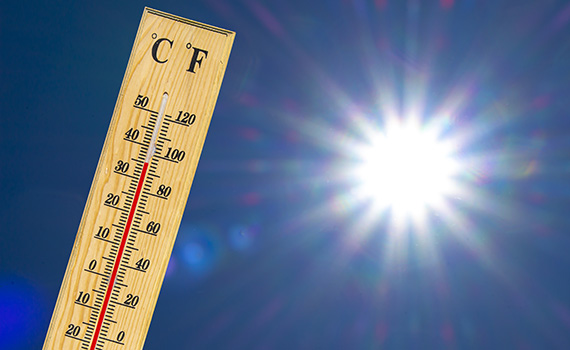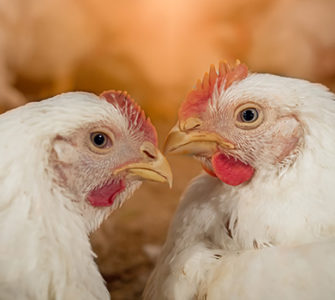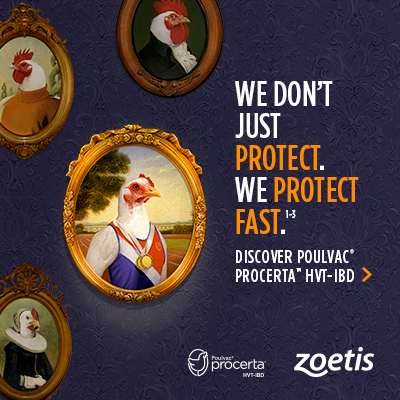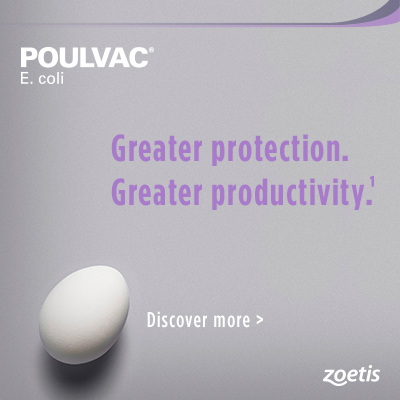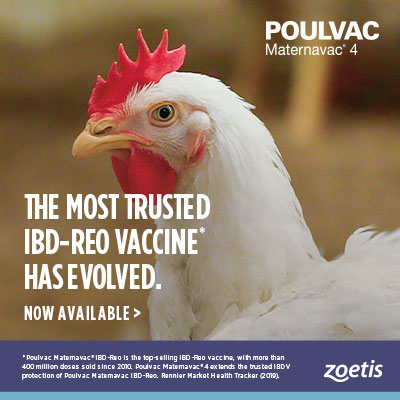5 steps to preventing heat stress in layers
By John Brown, DVM
Senior Technical Services Veterinarian
Zoetis
With hot weather upon us, it’s time for layer operations to make sure they’re prepared to prevent heat stress. Best-case scenario: We prevent hens from overheating. Worst case: Layers are heat stressed, leading to significant welfare and performance problems.
To properly prevent or manage heat stress, it’s imperative to understand how it occurs. A layer’s normal body temperature is about 105° F (40° C). Hens are comfortable with an ambient temperature of 65° F to 75° F (18° C to 24° C). When that temperature gets above 90° F (32° C), the more serious consequences of heat stress occur.1
In one study, heat stress was associated with a 31.6% reduction in feed conversion, a 36.4% reduction in egg production and a 3.41% reduction in egg weight, according to a review article from Purdue University and USDA’s Agricultural Research Service.2,3
The authors of the review point out that heat stress might also affect food safety. “Many recent studies have demonstrated that bacteria, such as Salmonella and Campylobacter, are capable of exploiting the neuroendocrine alterations due to the stress response in the host to promote growth and pathogenicity. Therefore, it is of great importance to be aware that environmental stresses, such as heat stress, can potentially alter the host-pathogen interaction,” they write.4
Other consequences of heat stress include increased water intake that can lead to wet manure and soiled eggs, and reduced immune function, which can impair vaccine efficacy.
1. Heat-stress basics
When a hen is too warm, she needs to lose heat. She does this in several ways. One is by convection, which is losing body heat to cooler air by spreading her wings.
Another way is by evaporation. When the house is too hot, moisture from the respiratory tract has to be used, causing hens to pant, which increases airflow over mucous membranes.
Panting is what leads to poor shell quality — thin, weak shells — because it disturbs the metabolic acid-base balance. Ultimately, it causes less calcium to be transferred to the shell gland, a deficit that can’t be corrected with diet. Furthermore, if panting is not effective and body temperature further increases, the hen becomes listless and may die.
It’s important to note that humidity is related to the ambient temperature. Higher humidity at any temperature increases bird discomfort, and evaporative cooling is less effective. Evaporative cooling is effective only when the relative humidity in the air is low.
2. Do not disturb
If birds are at risk of heat stress or are already overheating, it helps to avoid disturbing them, especially during the hottest part of the day, so they don’t get hotter moving around. Schedule most work in the house to be done in the early morning or in the evening when it’s not so hot (remember that late afternoon is the hottest part of the day).
It’s critical not to overstock cages. Birds need to be able to spread their wings to increase airflow around their bodies. If layers have to be moved on a hot day, place fewer in each transport crate and intersperse those crates with empty crates for better air circulation. If you can, delaying movement until the evening would be preferable. Postpone beak trimming to a cooler day or trim in the early morning before high heat sets in.
3. Ventilation ‘critical’
Proper ventilation is critical to prevent heat stress in layers during hot-weather months.
If your ventilation system fails on a hot summer day, the temperature in the house could rise by 60° F (15° C) within 1 hour.
To keep the house comfortable for layers, the total exhaust-fan capacity should be at least 3.5 liters per second per laying hen. You may need two air exchanges per minute.
Make sure your fans work well, that blades and louvers are clean and belts are properly adjusted for both tension and alignment. Poorly maintained fans will operate at 50% reduced efficiency. In addition to running fans throughout the day when it’s hot, fans should run overnight and early morning to bring in cooler air. Air inlets should be adjusted to achieve uniform airflow throughout the building.
Stand-by generators and alarm systems are essential equipment for preventing heat stress. I strongly recommend testing them at least monthly and setting the high-low temperature alarms in the sensitive range. I’ve seen many producers increase the temperature set point during hot weather so their alarms don’t come on as often, but the better approach is to use them as they are intended — to signal a problem before it gets out of hand and leads to more bird damage.
Foggers or misters need to be checked routinely and should run 2 minutes out of every 10 if the humidity is low.
At times when summer temperatures are extremely high, roof sprinklers may be needed. It’s also a good idea to keep grass and other vegetation on the air-inlet side of the building mowed so it doesn’t interfere with the inlets.
Layer-house insulation is ideally R 20 for walls and R 28 for ceilings to help keep the house warm in winter but cool in summer, but when insulation isn’t optimal, there needs to be greater reliance on other heat-control options such as foggers, misters or roof sprinklers.
4. Water system maintenance
At normal temperatures, 10,000 layers will drink 2,000 liters of water daily, but their intake will increase by 50% if house temperature rises to 90° F (32° C) — and that’s when you’re likely to have a problem with wet litter and soiled eggs. There should be adequate drinker space and more drinkers if layers are floor-reared.
Maintenance of the water system for cleanliness and function is another critically important chore if heat stress is to be prevented in layers. It’s easy to overlook a nonfunctioning drinker here and there; drinkers must be systematically checked to make sure they’re all working.
Water flow should be greater than 70 ml per minute per nipple. If it isn’t, the lines need to be checked for flow restriction. If there’s a buildup of iron and other minerals, it needs to be removed with polyphosphate and/or chlorine. Don’t forget to routinely check water filters and replace them as needed.
It’s helpful to cool the drinking water by flushing lines in the afternoon. Cool water helps bring down the birds’ core temperature. If the water is below 77° F (25° C), birds will drink more. Water over 86° F (30° C) will reduce their water intake, further reducing feed intake. Adding vitamins and electrolytes to the drinking water helps replace lost sodium, chloride, potassium and bicarbonate, but they are best administered before the development of extreme heat.
5. When to delay vaccination
If layers are due for vaccines at the same time they are experiencing heat stress, it’s best to postpone vaccination, since the impact of heat stress on the immune system can result in a less than optimal vaccine take.
Sometimes, the opposite problem can occur if birds are vaccinated when they’re overheated. If they’re panting, they may breathe in too much of a spray vaccine or ingest too much of a water-administered vaccine. In both of these situations, birds may exhibit signs of the disease that the vaccines are intended to prevent.
It’s hard to say exactly how long you should wait to vaccinate birds that have been heat stressed. If the stress lasted only a day and didn’t result in any significant performance or production problems, it’s probably safe to proceed as soon as the birds are no longer stressed. However, the adverse effect of heat stress on the immune system is going to depend on the length of time and severity of the heat incident; if birds were stressed more than a day, it’s probably wise to wait several more days before vaccinating.
I’ve been asked just how long it takes for a hen to recover her performance after heat stress. This also depends on how long the stress lasted. The usual problem is that hens don’t eat, and the reduced nutrient intake leads to smaller yolks and eggs. If they’re off feed only for 1 day, the reduction in yolk size may be minimal and go unnoticed, but if they are off feed for any prolonged period of time, the reduction in yolk development will be more severe and prolonged.
It’s the same with shell quality. The longer that acid-base imbalance occurs due to heat stress, the more severe will be the impact on shell quality. Once the acid-base balance returns to normal, shell quality should return to normal.
Most major chicken-producing regions of the country are in areas where summer heat can become extreme, but we can protect layers and prevent heat stress — if we’re prepared.
1 Hy-Line Technical Update. Understanding heat stress in layers: Management tips to improve hot weather flock performance. Hy-Line International, 2016.
2 Star L, Juul-Madsen HR, Decuypere E, Nieuwland MG, de Vries Reilingh G, van den Brand H, Kemp B, Parmentier HK Effect of early life thermal conditioning and immune challenge on thermotolerance and humoral immune competence in adult laying hens. Poult Sci. 2009;88:2253-2261.
3 Lucas JL, et al. Impact of Heat Stress on Poultry Production. Animals. 2013 June;2(2):356-369.
4 ibid.
POU-00103
Editor’s note: The opinions and advice presented in this article belong to the author and, as such, are presented here as points of view, not specific recommendations by Poultry Health Today.
Posted on June 14, 2021



